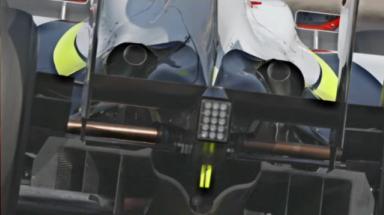Michiba:
I didn't intend to belittle you. Was just pointing out that the difference may not be aero-driven. Regarding the different sizes, I wouldn't think that the front would necessarily have to be bigger. The heat transfer is driven largely by mass flow through the duct. If you have a higher air velocity, which you would have because the airflow has not been disturbed as much as it would at the rear wheels, then you wouldn't necessarily need a larger inlet to achieve the necessary mass flow. The general uniformity of the airflow can influence the inlet size as well, with more uniform flow would require a smaller duct. It depends on the overall design.
As for directing the air coming out of the wheel, I really doubt that it would have an effect on underbody flow considering their is a slight upwash effect caused by the rotation of the tire. While there is a lower pressure region under the car, I'm not entirely sure it would be strong enough to pull that air underneath. I would have to think about it more. It would help if there was a copy of the video in English so that I could hear them describing what they're showing.
xpensive:
From
Fundamentals of Aerodynamics by John Anderson:
A diffuser is a divergent duct whose role is to slow higher-velocity air down to a lower velocity at the diffuser exit.
It's an application of the continuity of mass. Assuming constant mass flow through the diffuser:

Assuming incompressible flow by the low Mach numbers, it simplifies to:

As the area increases, the velocity decreases. As you stated previously, as the velocity decreases the pressure will increase. This is the role of a conventional single diffuser.
Concerning the DDD, I confess I don't completely understand the reasoning that went into the different designs. My initial thought is that some of the lower pressure airflow is released before it is slowed down to the freestream, and this "bleed air" acts on the lower side of the "upper deck" of the diffuser, generating downforce. That could explain the two openings below the rear light on the Williams and the single opening in the same location on the Brawn:


If my reasoning is correct, the upper deck would technically be a wing and not a diffuser. So yes, in this case, the airspeed from under the car would affect the downforce because the airflow acts on the extra wing. However, a diffuser (by strict definition) does not specifically generate downforce, it conditions the exit flow. However, if you claim that because the flow from the diffuser acts on the upper wing then it could be considered part of the diffuser. This is what I was alluding to when I asked if we were saying the same thing different ways.
What was the loophole that the initial DDD users were using for their legality argument? Were they claiming that it worked based on airflow from the diffuser and was therefore a part of the diffuser rather than another rear wing, which would be a method of getting around the lost width of the rear wing in the regulations?



